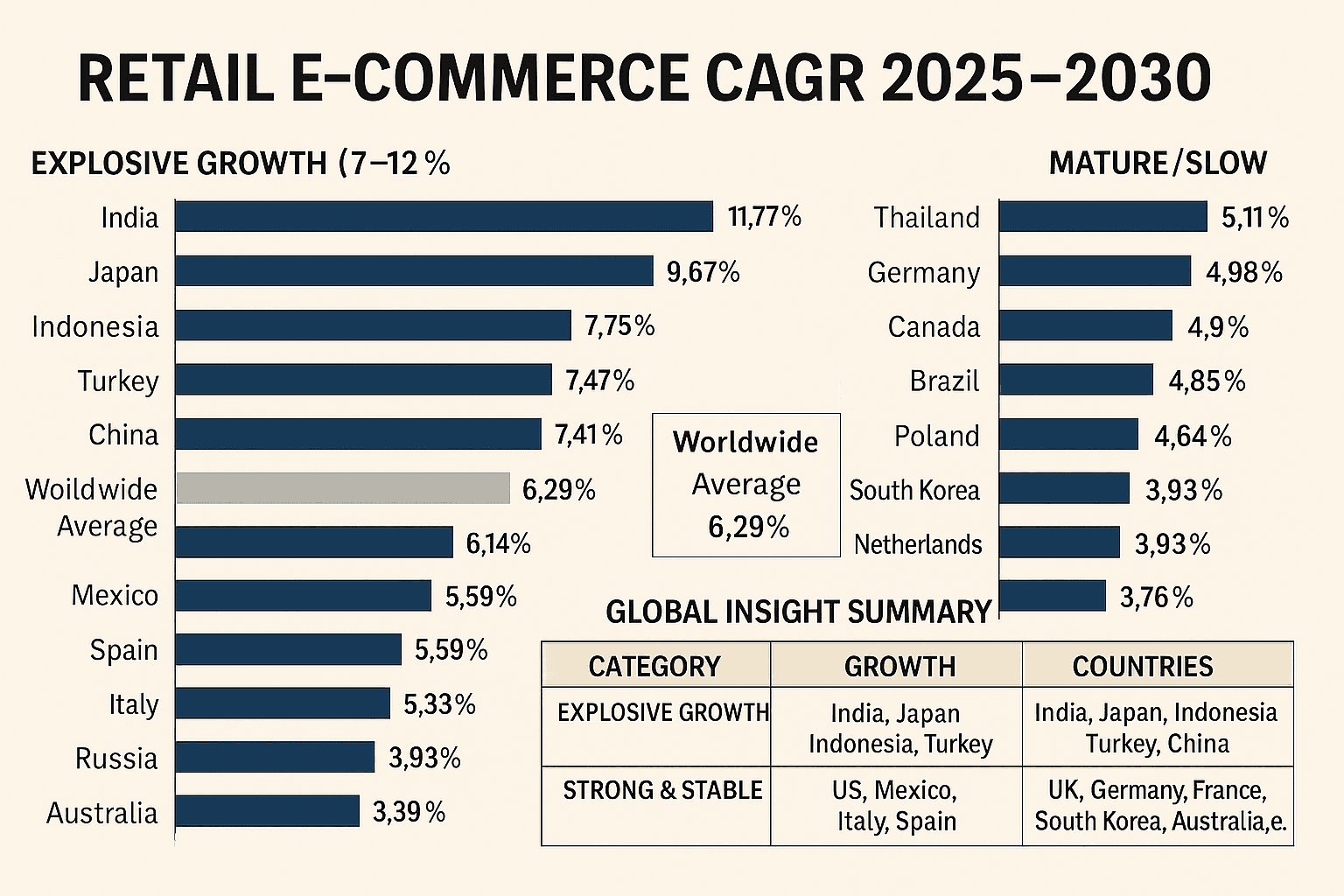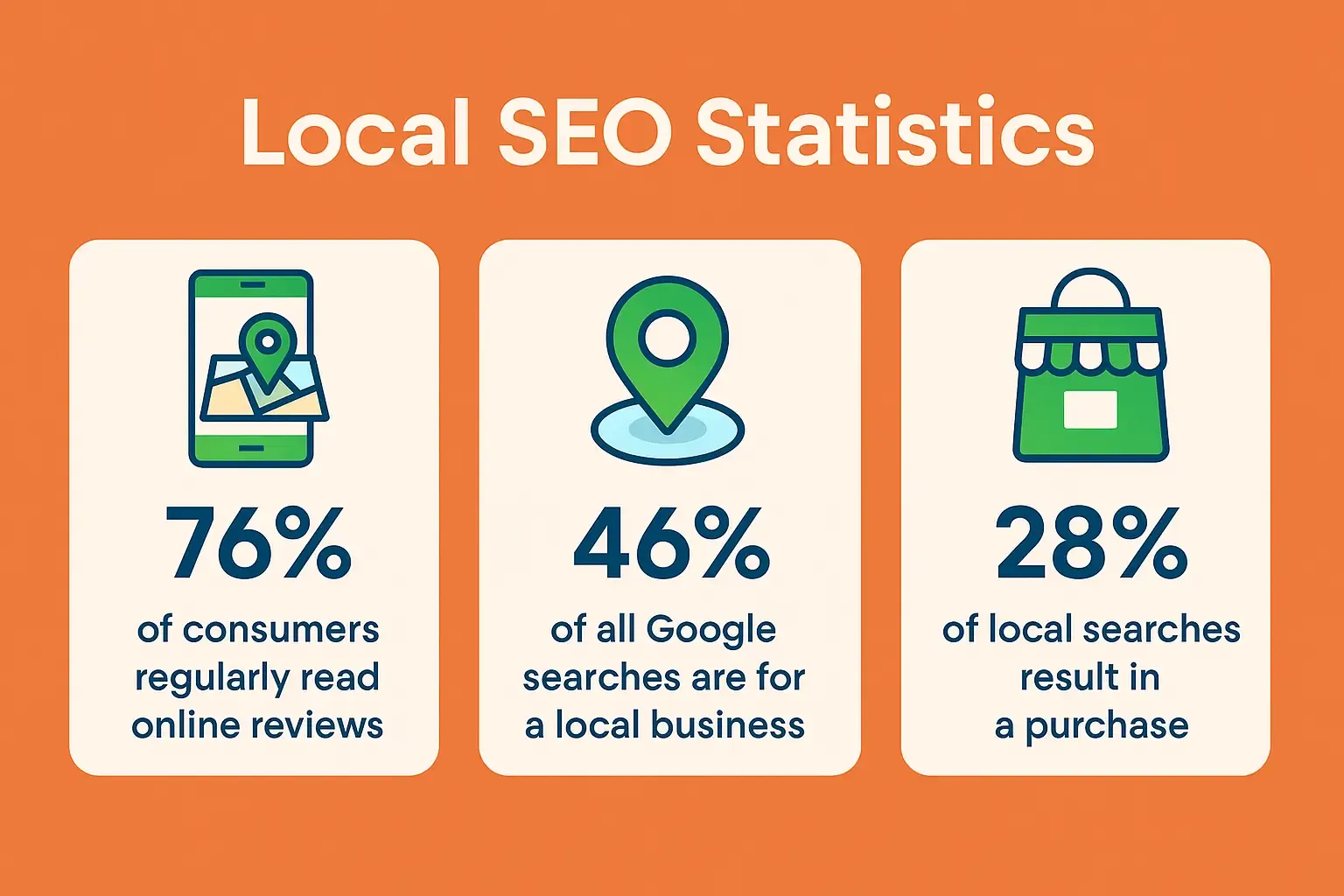
The chart compares the compound annual growth rate (CAGR) of retail e-commerce across major economies from 2025 to 2030. CAGR shows one thing:
How fast will the e-commerce market grow each year on average?
A higher CAGR indicates faster market expansion and more opportunities.
Here’s how the landscape looks.
1. The Fastest-Growing E-Commerce Markets (Category: High-Growth Zone — 7% to 12%)
These countries are about to experience an e-commerce boom. If you want an early mover advantage, this is where you look.
India – 11.77%
India leads the world. That means:
• Rising middle-class income
• Cheaper internet
• Tier-2 and Tier-3 cities shopping online
• Exploding mobile penetration
India will be the most important e-commerce battleground of the next five years.
Japan – 9.67%
Japan is already a mature economy, so a 9.67% CAGR is massive.
This reflects aging demographics + convenience-driven shopping + fast logistics.
Indonesia – 7.75%
Young population + mobile-first behavior = huge potential.
Turkey – 7.47%
High digital adoption and a rising entrepreneurial market make Turkey a sleeper giant.
China – 7.41%
Already the world’s largest e-commerce market, and still growing fast.
What this category means:
These markets will attract:
• More cross-border sellers
• Global brands expanding aggressively
• More payment and logistics innovation
If you’re entering early, you get lower competition and cheaper acquisition.
2. Mid-Tier Growth Markets (Category: Healthy Growth — 5% to 7%)
Worldwide Average – 6.29%
This benchmark helps you compare:
Above 6.29% = outperforming the world
Below 6.29% = slower-than-global growth
Mexico – 6.14%
Growing economy + strong mobile adoption.
Huge opportunity for D2C brands.
Spain – 5.9%
Stable growth, rising online grocery, fashion, and electronics.
United States – 5.59%
The U.S. is large, established, and competitive — but still growing at a solid pace.
This growth is mostly driven by:
• Subscriptions
• Quick-commerce
• Same-day delivery
• Social commerce
Italy – 5.33%
E-commerce adoption is still climbing steadily.
What this category means:
These markets are great for brands seeking stable, lower-risk, long-term growth.
3. Slow-Growth Markets (Category: Mature or Saturated — Under 5%)
These are markets where e-commerce is already developed, so growth slows down.
Thailand – 5.11%
Germany – 4.98%
Canada – 4.9%
Brazil – 4.85%
Poland – 4.64%
South Korea – 4.54%
Netherlands – 3.93%
United Kingdom – 3.93%
France – 3.76%
Russia – 3.51%
Australia – 3.39%
Here’s what’s happening:
• These markets already have high online shopping penetration
• Competition is fierce
• Logistics and payments are mature
• Incremental growth is harder to achieve
What this category means:
Winning here requires better branding, stronger fulfillment, and innovation — not just “being online.”
4. Global Insight Summary
If you sort the world into opportunity clusters:
This tells us one thing:
The next wave of e-commerce dominance will come from Asia and emerging markets.
How to Make Smart Decisions Using These Stats
1. Where to expand your e-commerce business
Choose countries above the worldwide CAGR average of 6.29%.
These are the markets where your store will naturally grow faster.
Priority markets:
India, Japan, Indonesia, Turkey, China, Mexico
2. Where to invest in localization, translation, and logistics
Markets with >7% CAGR deserve deeper investment:
• Local language SEO
• Faster delivery options
• Local influencers
• Marketplaces (Flipkart, Shopee, Lazada, Rakuten, Trendyol)
3. Where competition will grow fastest
High-growth markets invite new brands.
If you enter late, ad costs rise and margins shrink.
Enter early to lock in:
• Market share
• Loyal repeat buyers
• Cheaper acquisition
4. Where you should NOT overspend on advertising
Slow-growth markets (UK, Germany, France, Australia) have high CPCs and heavy competition.
Better strategy:
• Niche positioning
• Strong brand building
• Subscription or loyalty programs
• Higher-quality content and CRO
5. Where to focus on a mobile-first strategy
Countries like India, Indonesia, and Turkey are mobile-dominant markets.
Invest in:
• Fast mobile pages
• Wallet payments
• App-based selling
• Social commerce
6. How investors should read this chart
If CAGR >7%, the market is in growth mode → higher potential returns.
If CAGR <5%, the market is in maturity mode → safer but lower-return investments.
7. What startups and SaaS tools should target
Launch your tools in fast-growth regions first:
• Logistics and warehousing tools
• Chatbots
• Payment solutions
• Marketplace management
• Customer retention tools
Fast-growth countries adopt tech faster.
Final Takeaway
The U.S. or Europe will not shape the next five years of e-commerce.
It will be shaped by Asia, led by India, Japan, Indonesia, Turkey, and China.
Understanding these numbers helps you:
• Choose the right countries
• Spend money where growth is rising
• Avoid saturated markets with low ROI
• Build faster, smarter, and with less risk


